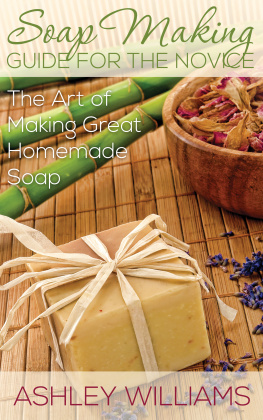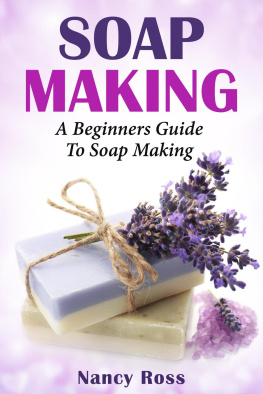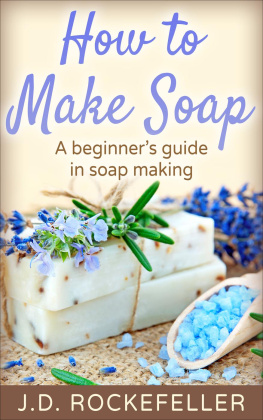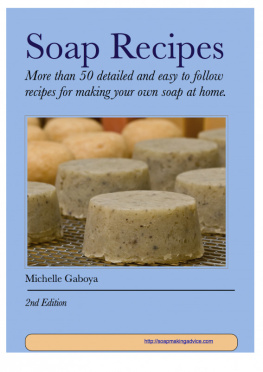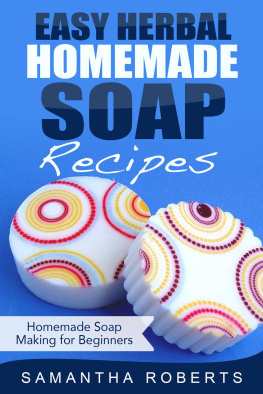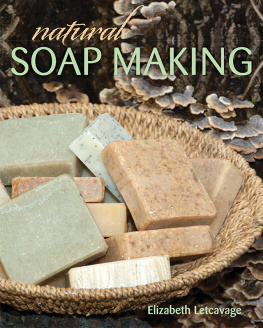This book is dedicated to mygrandmother who taught my mom how to make homemade soaps and she passed on theskill to me.
Chapter 1- An Overview of Homemade Soap Making
Soapmaking is often done for fun and profit. It is actually easier than most peoplerealize and with the right method it can be a hobby for the whole family. Whilethere are several ways to make soap, melt and pour and cold press are two ofthe more common methods.

Themelt and pour method is the easiest way to make a great bar of soap, and it isthe one you will want to employ when looking for an enjoyable activity to dowith your family. For the melt and pour method, you will need a melt and poursoap base. Melt and pour bases can be found in most craft store and online.They come in a variety of sizes and types, including organic recipes andspecial ingredients such as Aloe Vera or olive oil. Further, you will need asoap mold, a microwave and a heat safe container. Finally, you will need todecide what is it that you want to include in your soap, such as colorants,fragrances, or essential oils.
Itis important to know that a fragrance is different than an essential oil, asfragrance oils are man-made so to speak, and such, they can be formulated tosmell like anything. In contrast, essential oils only come from those thingsthat are found in nature, i.e. lemon peels, flowers, etc. Both are greatchoices and ultimately, it comes down to your own, as well as, your customerspreferences.
Forfolks looking for all-natural and organic products, essential oils are a must.The same principle applies when adding color to your soap. The most commonall-natural colorants are oxides and the majority of micas; however, be sure tocheck the label. There are several non-natural colorant options as well.Artificial color will provide brighter hues, and while they are approved to beused in soaps, they might be off putting for some.
Onceyou have everything gathered, chop up your soap base into about 1 inch cubes.Place the cubes into your heat safe container and then into your microwave forabout 30 seconds. If your base needs further heat, put it in your microwave at10 second intervals and be careful not to boil your soap. Next, place theingredients of your choice into the melted base, stir slowly but thoroughly,and pour into mold. Let harden for 2 to 4 days. Once sufficiently firm, unmoldyour soap and leave it in a safe place to cure for 6 weeks before using.
Theother common method for making soap is the cold press method. In the melt andpour method no soap is actually made, but rather raw soap is repurposed withthe help of various ingredients such as fragrances, essential and other oils,herbs, colorants, etc. Using the cold press method, you will make real soap.While cold press soap making is still easy and fun, a few precautions should betaken. Firstly, keep little ones out of harms way.
Coldpress soap making needs to take place in a child and pet free zone. Second,make sure the place where you are making soap is well-ventilated, as lye throwsoff harmful fumes while heating up. Third, wear long pants, shoes, gloves,respiratory face mask, and eye protection. Fourth, keep vinegar nearby. If youaccidently get lye on your skin, the vinegar will help neutralize the chemicalburn. Lastly, when not in use, store your lye up high and preferably in alocked container.
Nowthat all the safety precautions are in place, you can start making soap. One ofthe easiest soaps to make is olive oil soap. Olive oil soaps are both personaland customer favorites due to its moisturizing properties and the benefits theyprovide for the skin. The best type of olive oil for making soap is the mostinexpensive one, usually bright yellow in color. Do not use high-priced oliveoils, such as first press, as it does not work well for soap making. If youprefer, you can also buy special soap specific olive oil from some craft storesand online. The other two main ingredients for this soap are lye and distilledwater.
Thefirst thing you do is add 2 oz. of lye to 6 oz. of water. It is important toremember to always add the lye to the water and not the other way around, whichcould result in a thermal reaction. As you stir the lye and water mixturetogether, it will heat up and put off fumes until it becomes clear again. Whilemixing, it is important to remember to not stand directly over the container soas not to breathe in the harmful fumes.
Whenthe lye is clear and heated through, pour it into the olive oil that has alsobeen heated to approximately 125 degrees. Keep stirring for a few minutes untilthe mixture comes to a trace, or is slightly syrupy. From this point on, justlike in the previously described melt and pour method, you can add otheringredients such as fragrances and coloring agents, however this is completelyoptional. Let your soap sit for 2 to 4 days and then take it ou of the moldbefore putting it in a safe place to cure for 6 weeks before using.
Nowthat you know two great methods for making soap, go make some! The melt andpour method is a favorite because of its simplicity and great for people justbeginning their journey into the world of soap making. With this safe and easymethod you can plan a family night having each of the kids make their very ownbars, or you can make soaps especially to your liking, i.e. fully organic andfragrance free.
Thecold press method is real live soap making and it does require that you takeimportant safety measures. However, once these precautions are taken, thepossibilities for making soap become endless. You can try to formulate specialblends based on your own needs or take soap making to the next level and sellyour products at the local market or online. Whether it is just a hobby or anew business venture, soap making is something that can be done and enjoyed byalmost anyone.
Chapter 2- Equipment andIngredients Required For Soap Making
Makinghandmade soap has been modernized since that craft was a necessity inhouseholds. Today it is a luxury not only for it permitting customization withfavorite scents and oils, but to avoid the many chemicals and commercialingredients found in soaps that are mass produced.
Whenpreparing for soap making, there are essentials you absolutely must have as asafety precaution. Safety is very important not only due to some of the acidingredients but also due to the use of a microwave for the cold process andcrock pots for the hot process. Chances of acidic burns must be avoided, andyour eyes must be protected completely by wearing goggles. In case of splash toskin, rinse immediately with water, then vinegar. If splashed into an eye,flush with water and go to emergency room for immediate treatment.


